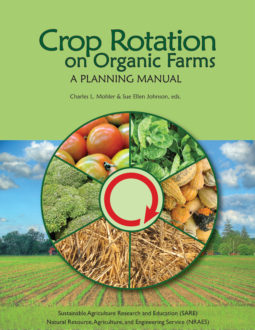Crop rotation is a critical feature of all organic cropping systems because it provides the principal mechanism for building healthy soils, a major way to control pests, and a variety of other benefits. Crop rotation means changing the type of crop grown on a particular piece of land from year to year. As used in this manual, the term includes both cyclical rotations, in which the same sequence of crops is repeated indefinitely on a field, and non-cyclical rotations, in which the sequence of crops varies irregularly to meet the evolving business and management goals of the farmer. Each field has its own rotation, and, consequently, each farmer manages a set of rotations.
Good crop rotation requires long-term strategic planning. However, planning does not necessarily involve identifying which crop will be grown on a field years in advance. Indeed, such specificity may prove futile as plans become disrupted by weather, changes in the market, labor supply, and other factors. Lack of planning, however, can lead to serious problems—for example, the buildup of a soilborne disease of a critical crop, or imbalances in soil nutrients. Such problems can result in an inability to meet the demands of a carefully cultivated market or in additional labor and expense. Problems caused by faulty rotation often take several years to develop and can catch even experienced growers by surprise. In fact, rotation problems usually do not develop until well after the transition to organic cropping. Since the crops grown by organic farmers are often different and more diverse than those grown in the preceding conventional system, the organic transition itself often rotates away from the previous crops and their associated problems. Most farmers are greatly tempted to plant excessive acreage of the most profitable crop or to overuse certain fields for one type of crop. Such practices can lead to costly problems that take many years to correct. his book is to help growers and farm advisors understand the management of crop rotations; avoid crop rotation problems; and use crop rotation to build better soil, control pests, and develop profitable farms that support satisfied families.
The purpose of this book is to help growers and farm advisors understand the management of crop rotations; avoid crop rotation problems; and use crop rotation to build better soil, control pests, and develop profitable farms that support satisfied families.
Although rotating among a diversity of cash and cover crops has numerous advantages, it poses substantial management challenges. The number of crops (and crop families) grown can be large, particularly on diversified vegetable farms and mixed vegetable-grain operations. Mathematically, this creates a huge number of potential crop sequences from which to choose. For example, if a farm produces ten different crops, these can be arranged in 90 two-year sequences, since each of the ten crops could be followed by any of the other nine. The same ten crops can be arranged in any of 5,040 unique four-year sequences! Of course, some sequences can be easily eliminated from the list of possibilities, based on experience or general rules of thumb, like avoiding successive vegetable crops in the same plant family, but the number of possibilities is still enormous. Further complications arise because, for market reasons, some crops are grown on a larger acreage than others. Large-acreage crops necessarily occur in multiple sequences with different small acre- age crops. Moreover, since certain crops grow well only on particular fields due to soil type, availability of irrigation, topography, etc., the problem of choosing effective crop sequences and allotting them to particular fields becomes even more complex.
This manual is intended to assist growers in plotting a course through the maze of decisions involved in planning crop rotations. The idea behind the manual is not to provide a list of rigid dos and don’ts. Rather, the intent is to provide perspectives on how to approach the challenge of planning effective crop rotations and to provide current information on which to base decisions.
